Optimal treatment for an adult with ADHD in a committed relationship has three specific parts, the first two of which are true for treating ADHD all of the time, and the third of which is specific to being in a successful relationship. Because good treatment “stands” on three legs I like to think of it as a three-legged stool. You need all three legs to optimally treat ADHD:
Leg 1: Making physical changes to your body. ADHD is the result of specific physical features in your body, including lower than normal levels of dopamine. These can be effectively addressed at the root cause (physical) level. Examples of leg 1 treatments include: medication, aerobic exercise, fish oil, better sleep and nutrition.
Leg 2: Making behavioral (habit) changes. Physical differences manifest themselves as symptoms and behaviors. Coping strategies such as retreat and denial that have been developed over the years without the benefit of physical changes are sub-optimal and often self-defeating within a committed relationship. So moving away from destructive coping strategies to creating “external structures” to support the ADHD partner is essential to improving your relationship. Examples of simple habit changes that can make a big difference include: lists and systems; alarms and reminders; anger management; separating bank accounts; hiring help; learning to not interrupt, etc. Cognitive behavioral therapy, so much in the news lately as a good treatment for ADHD, falls into leg 2 treatments.
Leg 3: Developing strategies to use when interacting with your spouse. These include communication strategies and creating a hierarchy of issues to attack. You can’t do it all at once, so picking the most meaningful symptoms and habits to address is an important step. A couple might decide to: designate a time to work together to plan household tasks for the week; develop verbal cues to stop escalation of disagreements; or schedule time to be together to overcome distraction.
To my knowledge, no one has studied the specifics of leg three, but numerous research studies have shown that combining physical and behavioral changes is better than either alone. Medication alone, for example, often helps, but is sub-optimal. Physically changing the way your brain works is a great start, but it’s what you do with that changed brain – i.e. your behaviors – that you and your spouse will notice most.
It’s a common misperception that a person with ADHD can make the behavioral changes without the physical changes by “just trying harder.” But that assumes that the person with the ADHD hasn’t been trying all these years. Not so! In general, people with ADHD try really, really hard, but something in their wiring (lack of focus, inability to create a hierarchy, impulsivity, etc.) has gotten in their way. To succeed, they need to get the ADHD symptom out of the way so that they can then make the behavioral change.
Moving ahead with treatment seems obviously beneficial to a non-ADHD spouse but often is complicated for the ADHD partner by years of repeated failures. One ADHD woman spoke of it this way:
“I have something of an aversion to medications, which is one issue for me. But the bigger issue is that I just have this feeling that I ought to be able to do this on my own, without the help of medication. Also, I have to admit that when I take the medications (intermittently) it is a painful reminder of how incompetent I am without the crutch. Too painful, really.”
The logic here, actually, is internally consistent and has to do with a poor self image developed over many years of failure. I suggested that she think of this chemical imbalance just as she would a hormonal chemical imbalance. If a doctor told her she wasn’t creating enough estrogen, for example, she would feel fine about taking medication to correct the issue and would never consider telling herself she ought to be able to create more on her own. ADHD is, among other things, a chemical imbalance. It, too, benefits from “righting” that imbalance.
If you or someone you love has ADHD, try thinking about treatment as a three-legged stool. It will help you both understand where opportunity exists to further improve treatment.
This post was adapted from The ADHD Effect on Marriage. For more details, see the book.

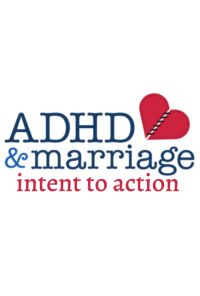

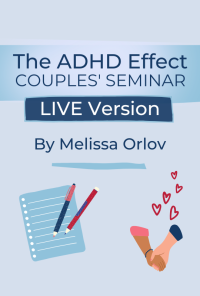
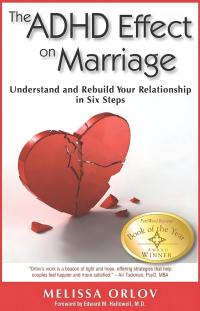
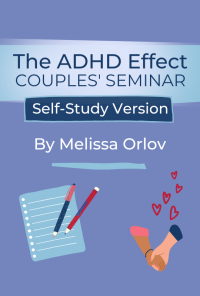
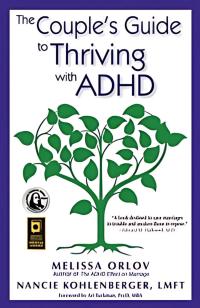
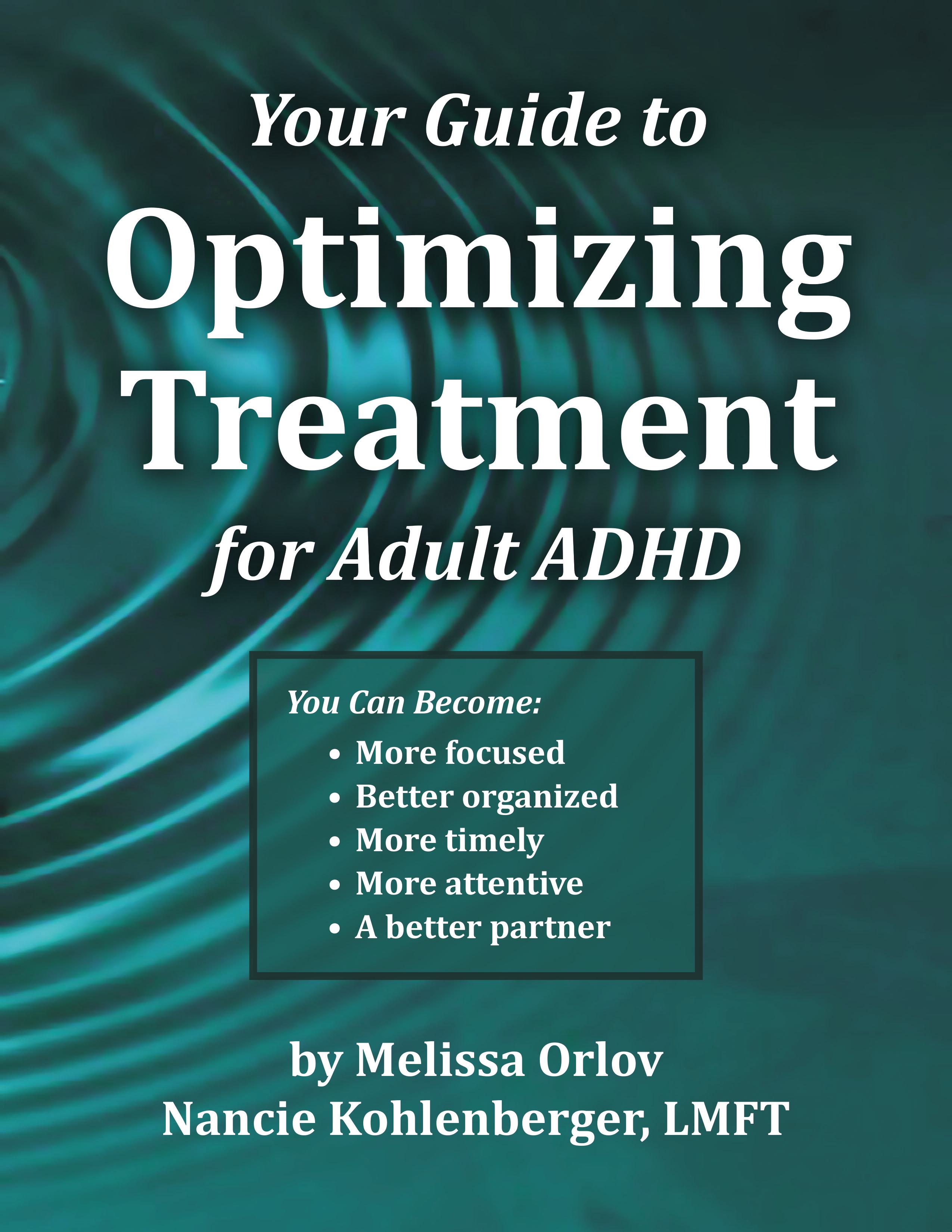

Comments
Thanks so much for sharing
Thanks so much for sharing these three legs of treatment for us with ADHD. I really like how you have this divided out into easy to understand and follow suggestions. This will be very helpful to share with my husband. I am happy to pass along this information and hope others will as well.
How much is truly ADD or intentional hurt?
Three years into a relationship with my s/o. Initially charming- so now I understand it was about the hyper-focusness of an ADD. At the beginning of our relationship, he presented me with books on relationship and communication, which he learned through his previous failed marriage. I thought I was walking into a relationship with someone that has the same values of the importance of healthy communication in a relationship. -
Now I feel like I am scraping for every little hope that will keep me sane. I am a health professional, which I embrace b/c it helps see things differently. However, at the same time- I often find myself saying "I should know better". I know I should be thankful that he has taken the first step- acknowledgement and attempt to start meds. His mother thinks his father may also have had ADD. She says she sees her husband in her son (my s/o). Lately, I have found myself obsessed with the traits of ADD as I'm learning more through books and this site- finding that I am making all excuses pointing the blame on ADD for all the hurts. But, is he not responsible at some level for the consequences of his behavior or is he not able to do that b/c of ADD? How do I balance my rationalizing. I tend to fall on "its the ADD" b/c it hurts less than thinking he meant to hurt me.
During a recent fight, he asked me with eyes of a totally different person I knew, "Are you staring me down!?" I was only standing in front of him not knowing what to say. It did not move him when he saw me crying all night. He denied he did that to me. I thought it was a gift to be able to reach the point of seeing our partners at their best (which he does have WONDERFUL traits I have not mentioned) and at their worse. I still love him- even until this moment despite all that I am writing appears negative. BUT it seems that I have become his enemy? Can love to an ADD person become meaningless in time- as I have read they thrive off of new stimulation???
As we non-ADDs to some level feel "unimportant" b/c of their inability to be emotionally available; I then wonder why my s/o is able to "control" is behavior and what he says in social settings or is more capable of showing consideration to those not so close to him? So, I analyze: maybe he does have some functional level to control his behavior and conclude that "it is just that he doesn't care to do it for me anymore"... So, how much of his hurtful behavior is to be blamed on ADD and how intentional was it?
I am so needing to hear him apologize at the same time trying to accept that its not going to happen. This morning, after 4 days of trying to climb out of my own depression after the last hurtful incident Friday evening, I found my compassion again and the courage to make the first step in breaking the silence btw us. It is usually me. Before I left to work this morning, I quietly and fearfully tried to hug him- not know how he was going to react. He kept turning away- so I just spoke. Told him that I loved him and don't want for us to end up hating each other and I don't want to hurt like this anymore. He just brushed me off as if I was bothering him-and says that he doesn't want the day to start off a sad note and tells me or maybe himself that "its going to be a good day- leave it alone.". I take a deep breath and realized - I won't get any further with my trying to reach him. Also afraid I will end up pushing him to say something ugly. I just told him "okay" and left. So, here I am again- on top of an already unresolved conflict that I am forced to sweep under the carpet. I feel so empty and question again- if his reaction was ADD or simply b/c he just doesn't care. I swear the feeling of "he just doesn't care", feels real! I am struggling with blaming my hurt on ADD the reality of how he just treated me. Perhaps all my forgiving and sweeping things under the carpet is my fault for the reason why he now doesn't see me anymore? Have I killed the love he once had for me? How do I know when it is ADD or when it's just him?
I know I am rambling, I am just so distraught and confused. Any answers please.
How much is Add or intentional hurt
Butterfly,
Your post struck a chord with me. I have been married 22 years and my husband was diagnosed approx 6 mos ago with ADD. I was the one in denial that he had it. We were in marriage counseling and I was convinced that he was making conscience decisions to act the way he was. After reading this blog and numerous other websites, I finally realized that he did, in fact, have ADD and that I wasn't the only person out there dealing with a situation like this. I noticed that you said your s/o was aware of his ADD and was reading up on it and trying to take his meds. My husband, too, is trying to "fix" himself. He is reading books and blogs and tries to make lists and create structure. However, I am becoming more convinced that nothing is going to change unless he gets help and possibly medication. "Trying" is not enough They also must make an effort to change. (Kind of like an alcoholic saying they have a drinking problem but not entering a 12 step program) I know it is very hard not to be depressed, I have been there. We have to keep telling ourselves that this is not about us or their feelings for us. I was/am having a hard time realizing that my life is not going to be how I envisioned it. Please encourage your s/o to get professional help. Reading your post really helped me realize that I must do the same for my husband. We can't do it alone and there is no shame in seeking help.
Resilience
So very much in common...
after reading what you wrote, I feel that along with so many other non-ADD partners/spouses we encounter and/or have a lot of the same patterns and issues that we deal with. I'm at the point of saying... 'love just isn't enough'! My husband of 7 years... I know he loves me, but his 'instant gratification' that he seeks out with other women online, or via email is just so hurtful to me. The way he blames me for his actions because he says i wasn't there for him is the most frustrating. It's like i want to stand up in class and say, "Um excuse me, I want a do over", I did not sign up for this. I ask myself often if I would have known about his behaviors or his disorder before getting married, would i have gotten married? And I most often would say yes... why? Because I am the person who's typically stronger emotionally, and financially within a relationship. Issues? Bring it on... i can handle it! But this recent diagnosis within the past year has me flat on my butt! I am to the point that I don't want to help, I don't want to be hurt again, but on the flip side.... I don't know how or if I can say goodbye to a man who I am still in love with!
I wish it was a 'fix-it' pill that would cure all that affects individuals with ADD as well as the affects they have on their partners.
So I said all of the above simply to let you know that hopefully within this site (since I am new) we can try to be the support that we all need that's not being obtained from our ADD spouses/partners!
Wow so I am not alone!
"I know he loves me, but his 'instant gratification' that he seeks out with other women online, or via email is just so hurtful to me. The way he blames me for his actions because he says i wasn't there for him is the most frustrating".
Please take it from someone that has been there for 21 years, do not allow him to make you feel you are responsible for his actions! "Seeking women online", hit me like a ton of bricks all over again and my unresolved issues surfaced over reading this! I can tell you after losing myself for months over something my ADHD/ADD husband chose to do, are precious days I will never get back. I can relate to your story and feel your pain and frustration... I have never posted anything before and am fairly new to this, but reading the posts has inspired me to become the best person I can be. I have started yoga classes and began to really do some serious soul searching to find happiness and peace that have been missing for the last 20 years of my life.
I am a business owner and proud mother of 2 teenaged boys whom are both graduating this year and I have promised that this will be a happy occasion with or without my husband. So many happy occasions have revolved around walking on egg shells and I realize how much it has effected my children... You can't turn back time! There is a song called "Sometimes Love Just Ain't Enough"- Patty Smyth please listen to it... After hearing this song I have found the light, it was a long dark tunnel for too long... I am still with my husband, however I am on a new path to freedom! 38 years old and finally see life is too short to be miserable...
prairiechick72
Thanks so much for your reply...for YEARS! I have felt that I was alone, and that I was the only one on earth that this was happening to. So much so, that I started to look in the mirror at myself to question if it was me? Was I wanting too much? I finally answered my own question December of last year.
To give a very brief summary, within 6 months of our marriage I found emails that he was having with an ex.... sexual content. I found porn sites that he was visiting, money he was spending. All of the things that I pointed out to him would violate my trust and our fidelity. Each and every time issues of this nature came up, it was something I wasn't doing that prompted his reaction. My all time favorite is when he told me that what he was doing wasn't cheating, that it was purely 'masturbatorial gratification' WTF? Are you serious? That's what prompts any cheater. Any way, I've forgiven him time and time again. Fast forward to 2 children later ...I gave birth to our youngest 10/2010. This is after having a miscarriage (that he took all the blame for..... looking back he did that only to have me soothe him when I needed the soothing)...we tried for a year to get preggo again. When we finally did, it was a very difficult pregnancy in which I was on semi bed rest, then if that wasn't enough, our baby wanted to arrive 11 weeks early. His wanting to arrive too early resulted in repeated hospital visits to get the 'shot' to stop the contractions. While preggo, I got laid off from a job that I had for 10.5 years. All of this added to the fact that we have a 3 year old who wants his Mommie's attention.
Now, I had given birth, and my 'darling' hubby decides that he's not getting enough attention from me in 11/2010, this is after I tearfully expressed that I was in post partum and needed to talk to my OBGYN ASAP. Do you think he was there for me? Of course not ....instant gratification he did. He reached out to his 'sexual/attention' crutch that's been the 3rd wheel in our marriage from the door. The last straw was on Dec 28th, 2010 when I went into his office to find that he had the audacity to be skyping with this very same female! In our home, on the PC that I purchased for him, and not to mention within ear range of our 3 year old. To say the least I was beyond livid!
Fast forward to today ....this is after he walked out of therapy that he said WE needed as a couple because of MY issues (lol). I am way better off than I was in 12/2010. Today, I live ...I live for myself, and for my/our son's. I can no longer walk on egg shells, wonder if he's doing something to hurt me again, not looking at his cell phone history, not asking where he's going when he leaves ....I am just not going to entertain his 'issues' and lose myself in the process as I've done in the past.
I listened to the song you suggested ....I played it for the hubby. His response? "so love isn't enough? r u leaving me?" All I could think of is... here we go again! I often wonder how much of his actions are really ADD related, vs how much is just simply him. I love my husband ...on his good days, he reminds me just why he 'rocks my boat', why I love him to the core. But....that isn't enough any more! Will I leave? I use to say no... but I find myself knocking on the door to happiness. If happiness can not be obtained with him? It will be enjoyed without him. I owe it to myself, and my boys! I realized that hurtful day in 12/2010 that I WILL NOT be the POSTER woman for my son's on how NOT to treat their spouse/partner. I am a much stronger me for finally getting fed up and began loving ME again!
So yes, I agree with you.... if my/our husbands join in with living life with us? Great, but I will no longer revolve around him, nor walk on egg shells!
Thanks so much for reminding me that yes, unfortunetly there are other strong women who are enduring, and conquering the same as well as worse issues than I am!
:-)
to prairechick72
How long has your husband been aware or diagnosed with ADD/ADHD? I would be very hurt as well if I found out my s/o was seeking other women on-line.... Yes, instant gratification.... no patience in understanding why you may not be there or just could not be there for him. As I learned that distancing myself... or was it a learned thing in order for me to survive in the relationship? was my only choice to keep from going insane. I did eventually lose myself. I question myself and him and the universe----- how much of the hurts they cause are b/c of ADD or a conscious decision- as you posted how you lost yourself over something your husband "chose to do"-- something he cannot undo. I ask how long your husband as been diagnosed b/c I am curious to know if it was recently, is he willing to get help. OR if he has known it for awhile, has he had treatment-- therefore unsuccessful?
Mariposa....
Hi.... the hubby was diagnosed with ADD April 2010. Yes he's willing to get help ....but only if I accompany him. I have no problems doing that; however, I can not hold his hand...I am raising our son's 80%, 19% is by my mom (who resides with us, and we pay her instead of putting the boys in day care....I will not have the boys in 'stranger care' until they can talk...around 3). 1% (and that's being generous) is what my husband contributes to the child rearing. I could write a book on what I've endured, but what I've learned not to get wrapped up in as I have in the past.
Here's the kicker ...both his parents are therapist! My husband was diagnosed with ADHD when he was a child, but because his mom felt the person who diagnosed him was completely wrong, he's been treated for depression most of his life. Because he's been treated for depression, on depression medication and tried (for attention only) to commit suicide in the past.... I can not even get life insurance on him!!!!! I swear, the issues that have come up since we've been married? OMG! One would think that I should be locked away in a padded room. Prior to getting married, I insisted that he get the STD tests, AIDS test, show me his credit report, and/or criminal background check....all of this, we both exchanged info...... I sure as heck should have gotten a test that would have listed all types of medication that he was on. I wish I could have obtained the same type of report that life insurance carriers get when they process insurance requests! I would have then decided if I wanted to be with him, and if I wanted to have children with him because most of the disorders are genetic!
I wish you the very best of luck and success ....you/we have a long road ahead if we wish to remain and/or continue to be with the ones we love. I guess my situation is a bit different because we have kids. I am so scared to leave my kids with him a lone (which I do not do at all)...because of his mental instability as well as his lack of patience which is a must when you have kids.
You can hold his hand - go once.
You can hold his hand. Go with him once. Leave the kids with grandma. He’s told you he’ll get help if you go with him – so just do it. If he’s serious, he’ll finally get some help; if he’s bluffing, well, then, at least you know where you stand.
It may be very helpful for your husband. Believe me, as someone diagnosed with ADHD as an adult, it can be tremendously difficult to face the fact that your brain is ‘different’ and that you may need medicine, therapy, support groups, coaches, psychiatrists….it’s daunting, especially at the beginning. Also, we often have a hard time with self-observation, so having someone who knows us well and sees us every day can be very helpful for a doctor to figure out problems, strengths, weaknesses, etc. - all of which will lead to more effective treatment.
And it may be helpful for you. You know your husband, sure, but it may be helpful to learn more about ADHD in general – both for interacting with your husband, and because it’s not unlikely that you’ll learn down the road that one or more of your kids has ADHD too. Time to start learning how do help them face the challenge.
And after you’ve gone with your husband, once, you can decide whether or not to ever go again. Just give it a shot.
Thanks
I'll attend once...... I can not hold his hand... I need to attend a counselor on my own to help heal the hurts of the past and decide if i want to brace myself for any that my come in the future.
Thanks
There is a huge reason
There is a huge reason couples dealing with ADHD go to counseling together...to bridge the communication gap. Please try and look at this from a different perspective. If he is willing to go, that's one point in his favor..SOOOO many ADHDers won't go AT ALL. Second, going together is necessary, at least for a while, to help everyone involved (you, him, the counselor) understand the issues and what needs to be worked on. There are topics that we don't even discuss unless we are in a counseling session...we NEED counseling..together.
Eventually, after you've been able to help everyone identify all issues, then you can start going alone (or you can go alone in conjunction with couples sessions). I not only went with him, I had to literally drag him to the first few sessions...I didn't see it as holding his hand..I saw it as saving us both from ourselves and the hellish marriage we'd created.
I will try
I will try because I really do love my husband.... I'll attend sessions with him, but for my sanity....I have been seeing a therapist on my own for the past several weeks. Just to try and mend the hurt from past experiences. So far....? It's just been weekly vent sessions..... hopefully soon after venting, I'll get the necessary tools needed to begin to heal and hopefully move on in a positive way.
thanks
to "how much more"
As I read your comment, I almost thought I wrote that. Though, I come from a 3 1/2 year relationship (not married). We recently separated 3 weeks ago. I felt your pain when you as you describe yourself as the "stronger emotional" one, and "don't know how to say goodbye to a man who your still in love with". I will say in my case; the separation has brought upon unexpected light and realizations (so, far...) My fears and questions that are racing in my head and heart along with all the new information and readings about ADD are: "Is this the hyper-focusing stage?, how long will his feelings of realizing how much he loves me and has hurt me last?", "how much is all of this sincere, ADD or true personality traits?"
The positives for me and us are that he has made steps towards acknowledging and pursuing treatment. Unfortunately, there are not enough resources that are affordable. And our experience with Psychologist... there are FEW that are very educated and/or informed with ADD/ADHD. Medication is not enough- as an adult with ADD, they need to also follow up with therapy. (per Dr. Howell's books) Upon reading one of his books- I came across information on the AMEN Clinics. EXPENSIVE-- insurance does not cover ;-( So, unfair. We do not understand this? To my surprise and what gave me HOPE is that he paid the money and went to this clinic. He completed the 3 day process just this week. We are yet to see the benefits, but in his words, he is happy with the results and services he has received so far.
I believe I need counseling myself in healing with the negatives from the past and most recent hurts. I'm in search for a counselor or therapist that is at least fairly knowledgeable with ADD- afraid that if I describe the details of my relationship and issues to just any counselor or therapist, they would only label him as a jerk or worse- rather than relating it to issues with his ADD. At least I would like to believe that as well. The first step towards hope is your husband's willingness to seek treatment. I hope your husband will. I am in the phase of hoping to God that mine will continue treatment and not stop even when he thinks he is feeling better- as it is going to be a life long effort. Praying...
Our simple 1st two steps
We just learned my husband has severe ADHD. Together for 5 years, married for 1 year, we never knew what the real problem was until a few months ago. Luckily, he has accepted it and is getting treatment for it. (Meds, individual therapy for both of us, marriage therapy, and education). Our simple 1st two steps are: 1) We agreed to both read The ADHD Effect on Marriage for 1/2 hour every day, and then we would talk about what we've read (so that I would know that he actually DID the reading!) and 2) We set up a Master Chore List that has every member of the house responsible for very specific chores/tasks. (I was at the end of my rope with all the responsibility falling to me and something had to change RIGHT NOW.) We are still in the first week of using the master chore list, and so far it's been hit and miss, but I have hope (something I haven't had for a LONG time).
I know (because of all the reading I have been doing on my own) that I am extremely lucky that he has accepted this diagnosis and is so willing to get treatment. Obviously, without his involvement in treatment we would be headed toward divorce. Maybe these 1st two steps will help someone who is just starting out on this journey to get a foot hold on their sanity. (Yes, the garage is a mess, yes, there is an entire list of household projects that need to be done, but getting a grasp of what ADHD is, and how it works, has to be the 1st step in getting your lives back - the garage will follow.)
A hopeful wife.
Adderall and drug screening for employment
So, what are we supposed to do when my husband has been taking Adderall, gets a job offer, goes through the drug screen, TELLS them at the time what he's taking, and the employer declines to offer him the job b/c of the "amphetamines" on his drug screen?
I think that is illegal?